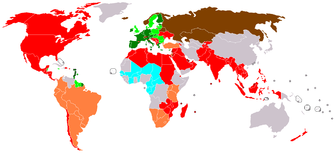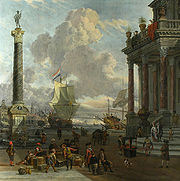- Complete economic integration
-
Trade barriers
Tariffs · Non-tariff barriers
Import quotas · Tariff-rate quotas
Quota share · Import licenses
Customs duties · Export subsidies
Technical barriers · Bribery
Exchange rate controls · Embargo
Safeguards
Countervailing duties
Anti-dumping duties
Voluntary export restraintsOrganizationsBy CountryComplete economic integration is the final stage of economic integration. After complete economic integration, the integrated units have no or negligible control of economic policy, including full monetary union and complete or near-complete fiscal policy harmonisation.
Complete economic integration is most common within countries, rather than within supranational institutions. A good example of this is a country like the United States of America which can be viewed as a series of highly integrated quasi-autonomous nation states. In this example it is true that complete economic integration results in a federalist system of governance as it requires political union to function as, in effect, a single economy.
Political Integration
 Stages of economic integration around the World:
Stages of economic integration around the World:
(each country colored according to the most advanced agreement that it participates into.)Economic union (CSME, EU)Political integration is required because for an economic union to be most effective it is necessary for all provinces to be at the same stage of the economic cycle. Although provinces is a narrow description as within a specific geographic area there is a much greater amount of mini-economies, all in different stages of the economic cycle; it is in theory possible for a single town to be in recession/boom whilst another is experiencing the opposite. In a practical sense it is best for as many of these economic microcosms to be at the same stage of the economic cycle as possible as it results in government policy having its effectiveness maximized, whether it be through the employment of fiscal or monetary policy.
To achieve economic harmonization requires increasing central control to pursue an economic area wide policy of inflation combatance and stability promotion. Though this is often viewed as a loss of provincial political sovereignty it is necessary to remove disparities and thus unfair advantages with certain firms across the economic area to provide the best conditions possible for the promotion of competition and therefore economic efficiency.
See also
- Fiscal union
Stages of economic integration Preferential trading area | Free trade area · Monetary union | Customs union · Common market | Customs and monetary union · Economic union | Economic and monetary union · Fiscal union | Complete economic integrationCategories:- Economic integration
- International trade stubs
Wikimedia Foundation. 2010.

